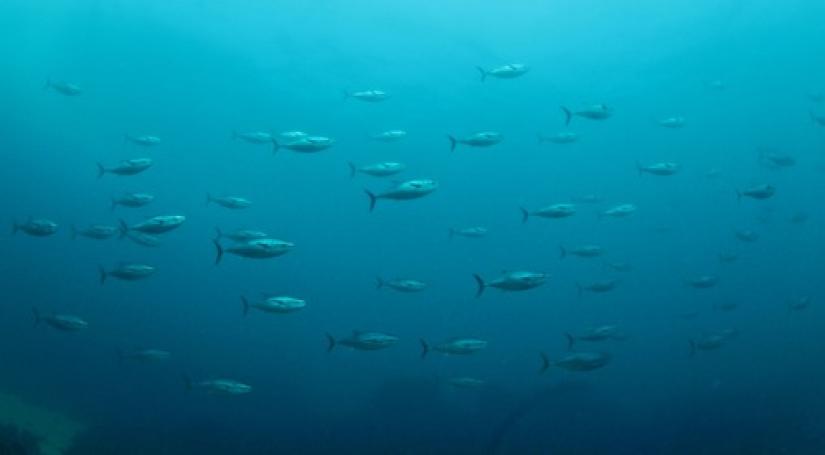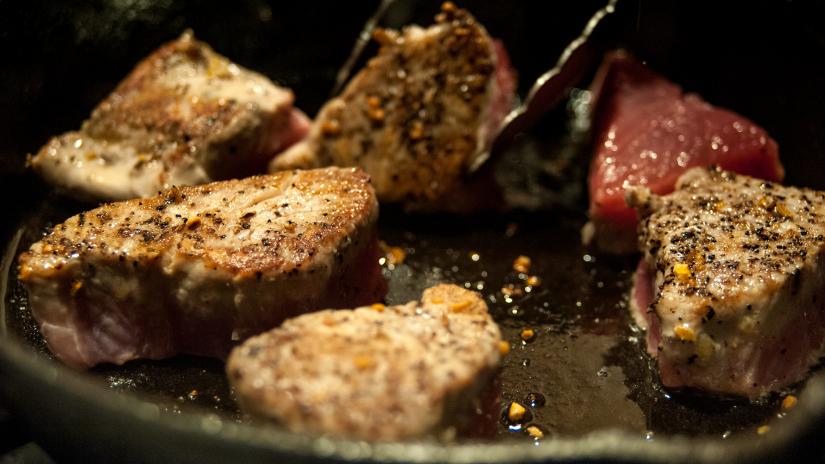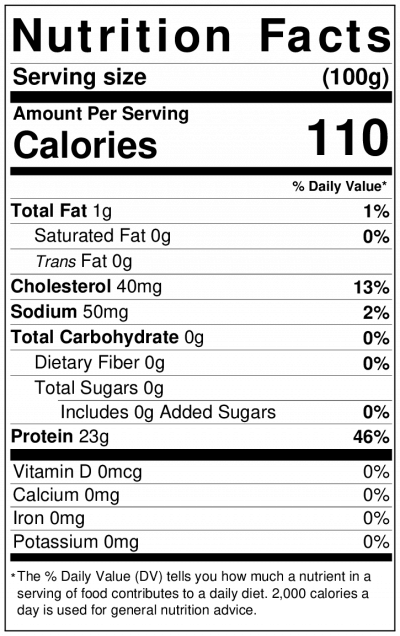Bigeye Tuna
Thunnus obesus
The Science
THE SCIENCE
This fish's blood has a counter-current heat exchange system that allows it to stay warm in colder, deeper water

Taxonomic description
- Has a large, robust body that is slightly compressed from side to side. [1]
- Back is metallic dark blue, lower sides and belly is whitish, yellow fins and lateral iridescent blue band runs along sides of live individuals. [1]
- Distinguished from yellowfin tuna by its bigger eyes and black-edged finlets. [1]
- Usually weighs 20-200 lbs. [2]
Distribution
- Found in tropical and temperate waters of the Atlantic, Indian, and Pacific Oceans. [2]
Life history
- Lives seven to nine years and matures between three and four years. [2]
- Spawns year-round in tropical waters, seasonally in temperate waters. [2]
- Releases 3-6 million eggs during spawning! [2]
- Eggs have oily coatings in order to float until hatched, about 24 hours after fertilization. [2]
Habitat
- Migratory, and will school with other tuna species at ocean surface. [2]
- Moves to deeper waters at night, has eyes adapted to low light levels and can regulate body temperature. [2]
- Feeds on fishes, cephalopods, and crustaceans. [1]
- Preyed on by larger tuna, billfish, toothed whales, and sharks. [2]
The Fishery
THE FISHERY
After a historic low level in 2004, Eastern Pacific bigeye tuna populations have been increasing and are now above target population levels!

Seasonal availability
- Available year-round. [3]
Regulatory and management authority
- Internationally overseen by the Inter-American Tropical Tuna Commission (IATTC) and the Western and Central Pacific Fisheries Commission (WCPFC). [3]
- Along the Pacific West Coast, the fishery is overseen by NOAA fisheries and, as established by the Magnuson-Stevens Act, the Pacific Fishery Management Council through the West Coast Highly Migratory Species Fisheries Management Plan. [3,4]
- As established by the Marine Life Management Act, the California Department of Fish and Wildlife (CDFW) collects data on this fishery through the Pelagic Fisheries and Ecosystem Program. [5,6]
Gear type
- Caught by purse seine, longline and handlines, and hook-and-line. [3]
Status of the fishery
- The three Pacific stocks, monitored closely by governing authorities, were deemed not to be overfished and not subject to overfishing . [3]
Potential ecosystem impacts
- Fishing gear rarely contacts the seafloor, so there are minimal habitat impacts. [3]
- Management measures, training programs, and observer programs are required for American fishermen to minimize the impact of bycatch. [3]
The Seafood
THE SEAFOOD
Although "Ahi" refers to both bigeye and yellowfin tuna, bigeye has a higher fat content and is typically preferred by sashimi lovers!

Edible portions
- Typically only the meat is consumed, but the rest of the fish can also be utilized. [2]

Description of meat
- Firm and moist with a mild, meaty flavor and reddish-pink color that has large flakes when cooked. [2]
Culinary uses
- Enjoy it raw, baked, broiled, grilled, sautéed, or smoked! [2]
- For a tuna nigiri recipe, visit Izzy Cooking. [7]
- For a Spanish tuna meatball recipe, visit Luxe Gourmets. [8]
Nutritional information
- Information for 100g of bigeye tuna shown on table at the right. [3]
- Bigeye tuna is a good source of Omega-3! [3]
Toxicity report
- As bigeye tuna may have mercury, recommended servings depend on age and gender. [3]
Seasonal availability
- Available year-round. [3]
References
[1] Luna, S. Fishbase. n.d. Thunnus obesus. Web. https://www.fishbase.se/summary/Thunnus-obesus.html. Accessed 4 February 2021.
[2] FishChoice. 2020. Bigeye Tuna. Web. https://fishchoice.com/buying-guide/bigeye-tuna. Accessed 4 February 2021.
[3] Fishwatch. 2020. Pacific Bigeye Tuna. Web. https://www.fishwatch.gov/profiles/pacific-bigeye-tuna. Accessed 4 February 2021.
[4] Fishery Management Plan for U.S. West Coast Fisheries for Highly Migratory Species. 2018. Pacific Fishery Management Council. Web. https://www.pcouncil.org/documents/2018/04/fishery-management-plan-for-…. Accessed 24 August 2020.
[5] Marine Life Management Act. n.d. California Department of Fish and Wildlife. Web. https://wildlife.ca.gov/Conservation/Marine/MLMA. Accessed 24 August 2020.
[6] Overview of the Pelagic Fisheries and Ecosystems Program. n.d. California Department of Fish and Wildlife. Web. https://wildlife.ca.gov/Conservation/Marine/Pelagic#52132542-overview. Accessed 9 December 2020.
[7] izzy cooking. 2020. Tuna Nigiri (How to make tuna sushi). Web. https://izzycooking.com/tuna-nigiri/. Accessed 4 February 2021.
[8] Matsumoto, M. Luxe Gourmets. 2015. Bigeye Tuna Albondigas. Web. https://www.luxegourmets.com/luxe-recipes/bigeye-tuna-albondigas-recipe. Accessed 4 February 2021.
[9] Hawaii Seafood. 2015. Bigeye Tuna (Ahi). Web. https://www.hawaii-seafood.org/wild-hawaii-fish/bigeye-tuna/. Accessed 5 February 2021.
[10] Shimada, A. NOAA fisheries. 2006. Thunnus_obesus Longline fishing research on the NOAA Ship OSCAR ELTON SETTE. Bigeye tuna. Digital image. Web. https://en.wikipedia.org/wiki/Bigeye_tuna#/media/File:Thunnus_obesus_(b…. Accessed 5 February 2021.
[11] bexlloyd. iNaturalist. 2017. Digital image. Web. https://www.inaturalist.org/photos/6554896. Accessed 12 February 2021.
[12] Tuna Harbor Dockside Market. Facebook. 2021. Digital image. Web. https://www.facebook.com/thdocksidemarket/photos/4210082502354334. Accessed 5 February 2021.
[13] McCullum, J. flickr. 2016. Tuna the way they like it. Digital image. Web. https://www.flickr.com/photos/sugarcreekphoto/24383222851/. Accessed 12 February 2021.



